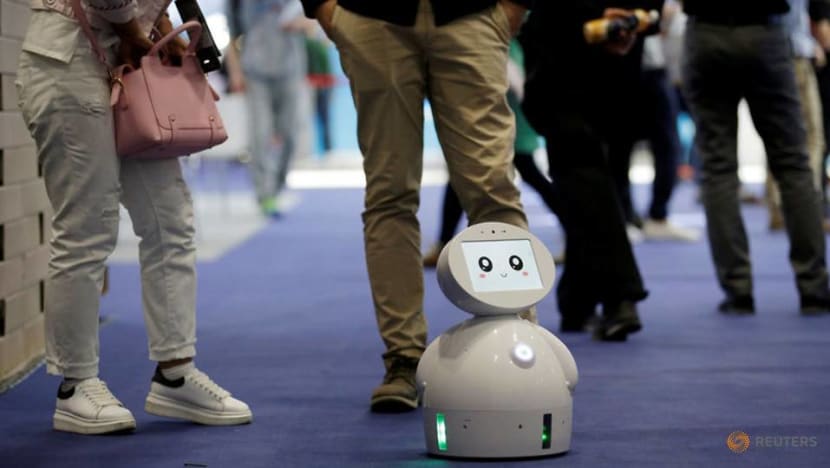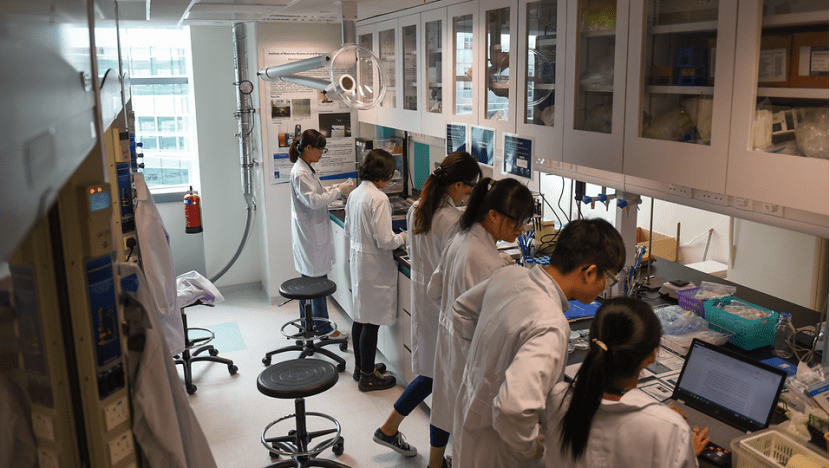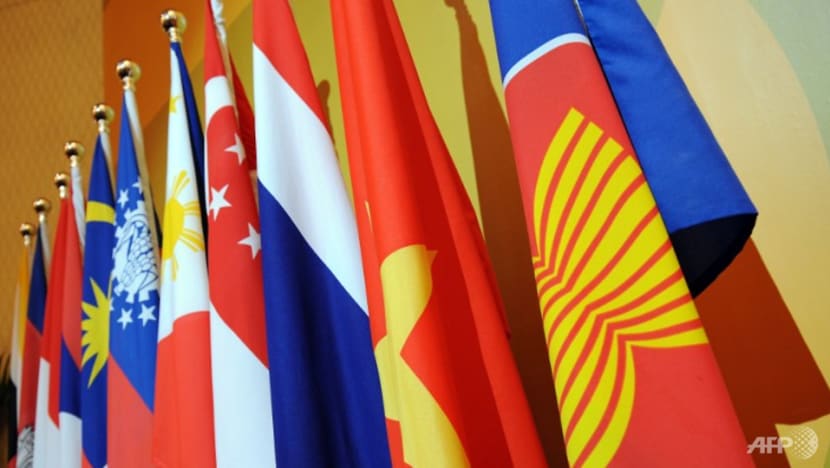commentary Commentary
Commentary: We now live in a ‘science fiction world'. We need to boost STEM education
STEM education offers fresh hope for dealing with a ‘science-fiction’ world, says PSB Academy CEO Derrick Chang.

Visitors stand around a ROBOTLEO robot at the Global Mobile Internet Conference (GMIC) 2017 in Beijing, China April 28, 2017. (File Photo: REUTERS/Jason Lee)
SINGAPORE: We are in midst of exponential change that seems to spring right out of a science fiction movie.
Humanised robots. Self-driving cars, supercomputing and singularity.
The fourth industrial revolution characterised by technology, and the fusing of physical, digital and biological worlds, is truly upon us. The question is how prepared are we to live in a world that is constantly reinventing itself?
To survive, adapt and be relevant in this brave new world, skills in science, technology, engineering, and mathematics (STEM) will be imperative.
STEPS LONG TAKEN
Long before Prime Minister Lee Hsien Loong identified STEM capabilities as critical to ensuring Singapore’s growth for the next 50 years in 2015, Singapore took a step in this direction, through the establishment of Agency for Science, Technology and Research (A*STAR) in 1991.
The objective behind A*STAR’s establishment was not just to advance Singapore’s economy but to also grow the biomedical sciences, energy and chemicals, and engineering industries.
Two hubs, Biopolis and Fusionopolis, opened in 2003 and 2008 respectively, giving Singapore a competitive edge in research and development (R&D).
Then Deputy Prime Minister Dr Tony Tan had said at the opening of Biopolis in 2003 that the Biopolis hub was conceived as the cornerstone of a vision to build up the biomedical sciences industry in Singapore, and by doing so, be able to generate economic growth, create jobs and improve the quality of life for Singaporeans.

There was also a realisation that the right talent is necessary to capture a share of this knowledge-intensive growth industry for Singapore as the kinds of jobs created and skills in demand evolve.
Education plays a crucial role in Singapore’s ability to produce graduates who are not only academically competent, but also equipped with the relevant and practical skills to thrive in this economy of the future. But are we going far enough?
READ: What a tech education today for a digital workforce tomorrow looks like, a commentary
GREATER DEMAND FOR STEM EDUCATION
According to a survey commissioned by Amgen Asia and the Global STEM Alliance in 2017 among 1,580 secondary school students and 560 teachers, approximately 90 per cent of students in Singapore enjoy one or more STEM subjects and are most likely going to major in one of them post-secondary school.
However, the survey also found that there remains a gap in engaging student and equipping teachers.
70 per cent of teachers feel students should be taught how STEM is used in the real world; 84 per cent of students would prefer more hands-on activities, while 78 per cent of them would like access to quality experiments.
This notion is echoed by Dr Kwok Sen Wai, a researcher at A*STAR, who said that schools should show students that the skills they learn in science and math classes can help to solve real-life problems. Students need to be inspired to take up STEM courses and ultimately be motivated to create something others can use.
In addition to the nuts and bolts – the specific skillsets and hands-on applications – education providers need to instil upon students a desire to upgrade, discover new things and continuously learn.
It is through this sort of mindset and our next generation’s appetite for learning that we can grow these capabilities collectively as a country.
This is a skillset that even those switching careers midway find valuable. To cite an example from PSB’s School of Life and Physical Sciences, Katherine Liew-Tan runs her own digital branding firm, after completing her communications studies at Nanyang Technological University.
But her keen interest in exploring potential business opportunities as she works closely with her clients from major skincare companies drove her to pursue a Bachelor of Science (Pharmaceutical Science) with La Trobe University, so she can cater to her clients’ needs better.
READ: Humanities at the heart of a holistic education in a tech-driven world. A commentary

STEM EDUCATION FOR ASEAN
Singapore’s role as ASEAN’s chair this year weighs in heavily in this conversation, with the theme being “Resilient and Innovation”. Countries are looking to partner Singapore as the region looks to move up the innovation ladder.
Nations like Indonesia are already seeing benefits from harnessing technological disruption, from retail to telecommunications, as they reap fruits of new business models and job opportunities.
This is where they can partner with countries like Singapore which has natural strengths in STEM education.
Singapore also tops Asia for developing human capital while countries such as Laos, Myanmar and Cambodia trail behind despite improvements from previous years, based on a World Economic Forum 2017 Human Capital Index.
A global talent shortage is making investments in education, including a focus on lifelong learning and high-skilled opportunities pressing, says WEF founder and executive Chairman Klaus Schwab.
On Singapore’s part, it is not enough for the country to be pioneering national initiatives such as Smart Nation and SkillsFuture. It requires close collaboration with its neighbouring countries to strengthen ASEAN’s ability to capitalise on these technological trends to move forward collectively.
A shining example of effective regional collaboration in STEM education is the Young Southeast Asian Leaders Initiative which completed its latest STEM Education Regional Workshop in Phnom Penh, Cambodia.
The Workshop saw over 50 youths aged 18 to 25 from Brunei, Cambodia, Indonesia, Malaysia, Myanmar, Philippines, Laos, Singapore, Thailand, and Vietnam discuss STEM education in the region.
BUILDING STEM CAPABILITIES
Similar initiatives are required with commitment and consistency. Singapore should work with other ASEAN countries and industry experts, and governments to deepen the region’s STEM capabilities.
There is also a role for tripartite partners including companies to play in STEM education. Employers need to embrace and advocate lifelong learning and society needs to celebrate and recognise a broad range of achievements.

Industry champions in STEM sectors can play a more active and direct role through offering expertise as adjunct lecturers, curating meaningful attachments and internship opportunities, and embracing lifelong learning by providing training for employees.
With strong support from partners, education providers can build a link for students to network and learn from industry practitioners. In turn, these partners can tap on students’ talents and qualifications, in matching talent with roles in STEM.
The end goal is for the region to build STEM capabilities, to contribute to ASEAN’s vision of becoming a dynamic, connected and growing region. Our future depends on it.
Derrick Chang is Chief Executive Officer at PSB Academy.












